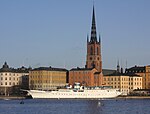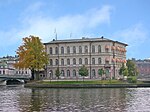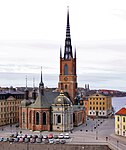Wrangel Palace
CourthousesGovernment buildings in SwedenHouses completed in 1802Palaces in StockholmRoyal residences in Sweden

Wrangel Palace (Swedish: Wrangelska palatset) is a townhouse mansion on Riddarholmen islet in Gamla Stan, the old town of Stockholm, in Sweden.
Excerpt from the Wikipedia article Wrangel Palace (License: CC BY-SA 3.0, Authors, Images).Wrangel Palace
Evert Taubes Terrass, Stockholm Riddarholmen (Södermalms stadsdelsområde)
Geographical coordinates (GPS) Address Nearby Places Show on map
Geographical coordinates (GPS)
| Latitude | Longitude |
|---|---|
| N 59.325 ° | E 18.0625 ° |
Address
Riddarholmen
Evert Taubes Terrass
101 23 Stockholm, Riddarholmen (Södermalms stadsdelsområde)
Sweden
Open on Google Maps











